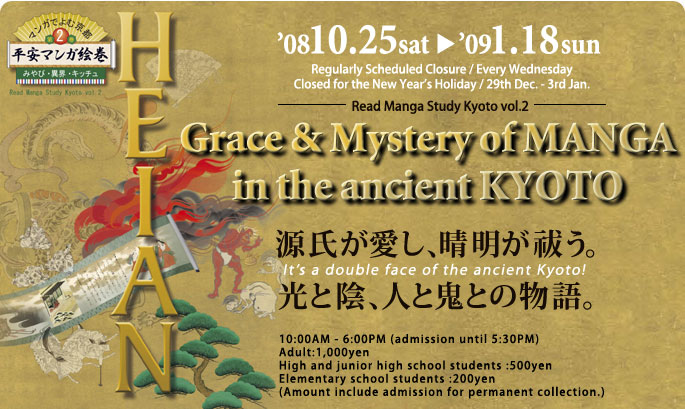
Admission (Special Exhibition)
Read Manga Study Kyoto vol.2
Grace & Mystery of MANGA in the ancient KYOTO
2008, is the one thousandth year since the Genji Monogatari (Tale of Genji) was written. In commemoration of this, the Manga Museum will be holding an exhibition show casing manga from Kyoto during the era that the Genji Monogatari was written in, the Heian Period (794~1180). The Genji Monogatari depicts the splendor and elegance of the Japanese imperial court culture, yet the Heian Period was also a time when society found itself troubled by evil spirits and ghosts; and fortune-telling and charms were popular. This exhibition will introduce a great many masterpieces of manga that illustrate the light and dark sides of Heian Period Kyoto, as well as souvenirs and character goods that serve as an example of how the culture of Heian Period Kyoto is familiar still, to the present generation, and that even the curious aspects of Japanese culture are a part of manga culture.
| Date |
Oct.25 to Jan.18(2009) 10:00AM - 6:00PM (admission until 5:30PM)
Regularly Scheduled Closures/Every Wednesday Closed for the New Year's Holiday / 29th Dec. - 3rd Jan. |
| Place | 2nd floor, Main gallery |
| price | Adult :1,000yen High and junior high school students :500yen Elementary school students :200yen |

The Genji Monogatari is a tale that depicts the refined emotions of the Heian Period nobility. A reproduction of the Genji Monogatari Emaki, the famous picture scroll of the tale(*), as well as life sized reproductions of the magnificent garments worn by the Imperial Court, and famous scenes from manga adaptations of the Genji Monogatari will be exhibited.

The people of the Heian Period were extremely afraid of curses and spells, and it was an era when fortune-telling and charms were popular. It was believed that ghosts would hold a procession down the main street of town at night and that anyone who witnessed it would fall ill and die. Also, there were government officials in the imperial court who specialized in divination and incantation. Above all, Abe no Seimei was known as a great conjurer. This exhibition will include a reproduction of the dreaded ghost procession using miniature figurines, and famous scenes from manga depicting the activities of Abe no Seimei.

In the year 794, Kyoto became the capital of Japan, and ever since then has come to be considered home to the hearts of the Japanese people. Japanese culture and sensitivity is encapsulated in a slightly curious(KITSCH) form through the souvenirs and character goods sold in Kyoto.

| Music Concert and Talk Show about Genji Monogatari | |
| Date | Oct. 25 / 2:00PM~3:30PM |
| Place | 1st floor, Multi-purpose Video Hall |
| Capacity | 250 people |
| Registration |
Via the homepage registration form or fax (+81-75-254-7424). Applicant's address, name and telephone number are required. (group applications must include all member's names.) Successfull applicants will be notified.
* entry finished |
| Talk by Jun Miura (Comic Artist /Illustrator)
※This talk is in Japanese only.
| |
| Date | Dec. 14 / 2:00PM~4:00PM |
| Place | 1st floor, Multi-purpose Video Hall |
| Capacity |
250 people
(Registration required on the day, in front of the Multi-purpose Video Hall from 10am. Limit of one ticket per person.)
|
| Concert of Japanese classical music for ancient court | |
| Date | Dec. 7 / 2:00PM~3:00PM |
| Place | 2nd floor, Multi-purpose Research Room 2 (Japanese style) |
| Capacity |
30 people
(No registration required, admittance in order of arrival.)
|
* Admittance to all events is free, however the normal museum entry fee still applies.
* Event schedules and performers may be subject to change.